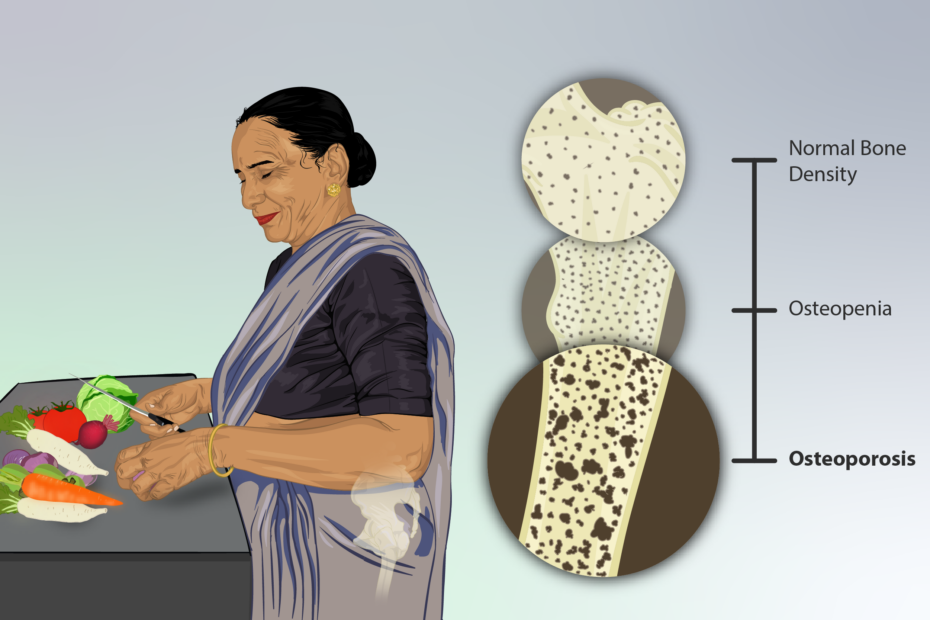Yoga, along with Pilates, has become increasingly popular in gyms and studios among all age groups as an entry into fitness. It helps with many processes of wellness and well-being, but it isn’t quite the magic cure-all it is sometimes presented to be and can do harm. Caution is advised for those with thin or brittle bones (osteopenia and osteoporosis) when performing some of the postures and twists.
Vertebral Fractures and Yoga Forward Bends and Spinal Twists
Forward bends and spinal twists are contraindicated for those with osteoporosis or even severe osteopenia. Osteopenia signifies loss of 10 to 20% of bone. While high impact exercises such as running or jumping can cause stress fractures, bending over to touch the toes or twisting the body toward the back of the room while holding hips squarely forward can produce a vertebral fracture. Those with osteopenia and osteoporosis of the spine are advised not to flex the spine or round the back in a forward movement.
Spontaneous crush fractures have been reported. This means it doesn’t take a fall to fracture, simply a wrong move for the weakened fragile bone. Osteoporosis is called “the silent disease” since often it isn’t diagnosed until a fracture or persistent pain is experienced, although bone may be weakening for months to years. Hairline fractures, crush fractures, and almost invisible fracturing of the spine gradually causes loss of height and pain.
Yoga Balancing Poses with Osteopenia and Osteoporosis
Balance is important to prevent falls and remain upright. There are many balancing exercises in yoga, all of which should be practiced. Practice walking on the ball of the foot and then the heel to build bone and to work on the muscles in the leg and foot.
A nice balancing flow routine in yoga is to go from chair pose to balance in the chair on one leg. (This is a pose where you sit back on the heels as if there is a chair behind you as in photo 3). Lift first the right leg and sit casually with the right crossed over the left and hold the posture while breathing in and out deeply. From that position, take the raised leg back to airplane (leg straight behind you with arms out to side if need be for balance.) This is done on both legs.
Either continue the flow without changing legs (if more advanced), or otherwise enter Tree Pose. (One leg is raised with the knee facing the side wall as in the photo found in Secrets to Perfect Yoga Poses). Balance is helped by pointing the knee to the side and down toward the floor. Spot yourself on a non-moving object. Always do each exercise on each leg.
Anyone Can Develop Osteoporosis
This isn’t only an older woman’s disease, nor only prevalent in Caucasian or Asians. Men and younger people too can develop brittle bones through immobility, medications, hormone deficiency, steroid use, or heredity. Anyone who has suffered fractures at different times in their life should request a bone density test to determine the fragility of the bones and to begin the work of protecting and strengthening them.
Bone can be rebuilt to some degree by weight bearing exercise along with medications and diet. When people fear falling and fracturing a hip because they have osteoporosis, this risk is secondary to the bones weakening to the extent that a fall happens. The question is whether the fall was caused by the osteoporosis or the fall made the weakened bone break and the person fell. Proper exercise is important, so is working with someone who understands osteoporosis and yoga.
References:
Lumbar Compression Fracture WebMD
Bone Heath and Osteoporosis–A Report of the Surgeon General (U.S. Department of Health and Human Services [HHS]
Spinal Performance and Functional Impairment in Postmenopausal Women with Osteoporosis and Osteopenia without Vertebral Fracture Osteoporosis International Volume 13, Number 6, 456-460.
